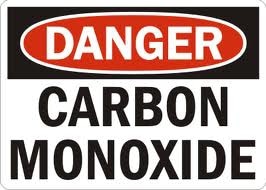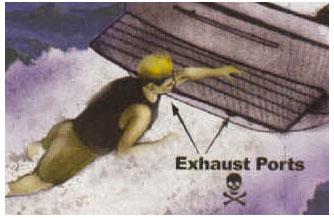
One of the great things about boating is the sense of freedom, the escape from the daily grind. It’s easy to “unplug” from stress on the water. Unfortunately, it’s also easy to “unplug” from important safety precautions. Consider the following situations:
- A young man in the water holding on to the swim platform while chatting with friends onboard.
- A large number of boats anchored close together on a hot summer night, with several running their air-conditioners.
- A houseboat anchored in a small, sheltered cove on a lake.
- A boat traveling slowly through the water with a noticeably high bow angle.
- A young woman “teak surfing” off the swim platform of her family’s boat.
What do these situations have in common? They are all potentially fatal due to the high risk of carbon monoxide poisoning.

Carbon monoxide is a deadly gas produced by the burning of any carbon-based fuel. It is invisible and has no taste or smell. Carbon monoxide from exhaust pipes of inboard engines, outboard engines, and generators can build up inside and outside of boats in areas near exhaust vents, such as the swim platform. People should never congregate or swim in these areas when the motor or generator is operating. Exhaust from other boats is another serious danger. A boat that is docked, beached, or anchored alongside another boat is vulnerable to carbon monoxide intrusion in the cabin and cockpit from its neighbors.
Educate Yourself to Educate Others
- Carbon monoxide is a quick and silent killer. It is also colorless and odorless.
- Fresh air circulation and staying away from exhaust outlets is the best way to avoid carbon monoxide poisoning.
- Experts recommend installing marine-rated carbon monoxide detectors, to alert boaters when the CO concentration on board is too high.
- Remember that life jackets save lives. Many who are overcome by carbon monoxide slip silently beneath the water. Fellow boaters often report that a person was “there one second and gone the next.” Life jackets give you a better chance of being saved.
Check Your Boat
- Make sure all exhaust hose ends are double clamped and securely in place.
- Look for exhaust leaking from exhaust system components, indicated by rust and/or black streaking, water leaks, or corroded or cracked fittings.
- Inspect rubber exhaust hoses for burned or cracked sections.
- Confirm that water flows from the exhaust outlet when the engines and generator are started.
- Listen for any change in exhaust sound that could indicate an exhaust component failure.
Blockage of exhaust outlets can cause carbon monoxide to accumulate in the cabin and cockpit area of a boat, even when hatches, windows, portholes, and doors are closed. Boaters should avoid anchoring in areas where outlets could be blocked. Backdrafting, otherwise known as “the station wagon effect,” occurs when a boat is operating at a high bow angle, traveling under four knots, or has been improperly loaded. This may cause carbon monoxide to accumulate inside the cabin, cockpit, and bridge, even when protective coverings are used and the boat is underway. People “teak surfing” or dragging off the swim platform, or water-skiing 20 feet or less behind a moving watercraft, are inhaling carbon monoxide exhaust.
Knowing how to spot and – more important – avoid dangerous situations can save lives. Boaters should do their part to educate others about common causes of carbon monoxide poisoning. Too many have lost their lives to this silent killer, so spread the word.
The U.S. Coast Guard is asking all boat owners and operators to help reduce fatalities, injuries, property damage, and associated healthcare costs related to recreational boating accidents by taking personal responsibility for their own safety and the safety of their passengers. Essential steps include: wearing a life jacket at all times and requiring passengers to do the same; never boating under the influence (BUI); successfully completing a boating safety course; and getting a Vessel Safety Check (VSC) annually from local U.S. Coast Guard Auxiliary, United States Power Squadrons(r), or your state boating agency’s Vessel Examiners. The U.S. Coast Guard reminds all boaters to “Boat Responsibly!” For more tips on boating safety, visit www.uscgboating.org.








